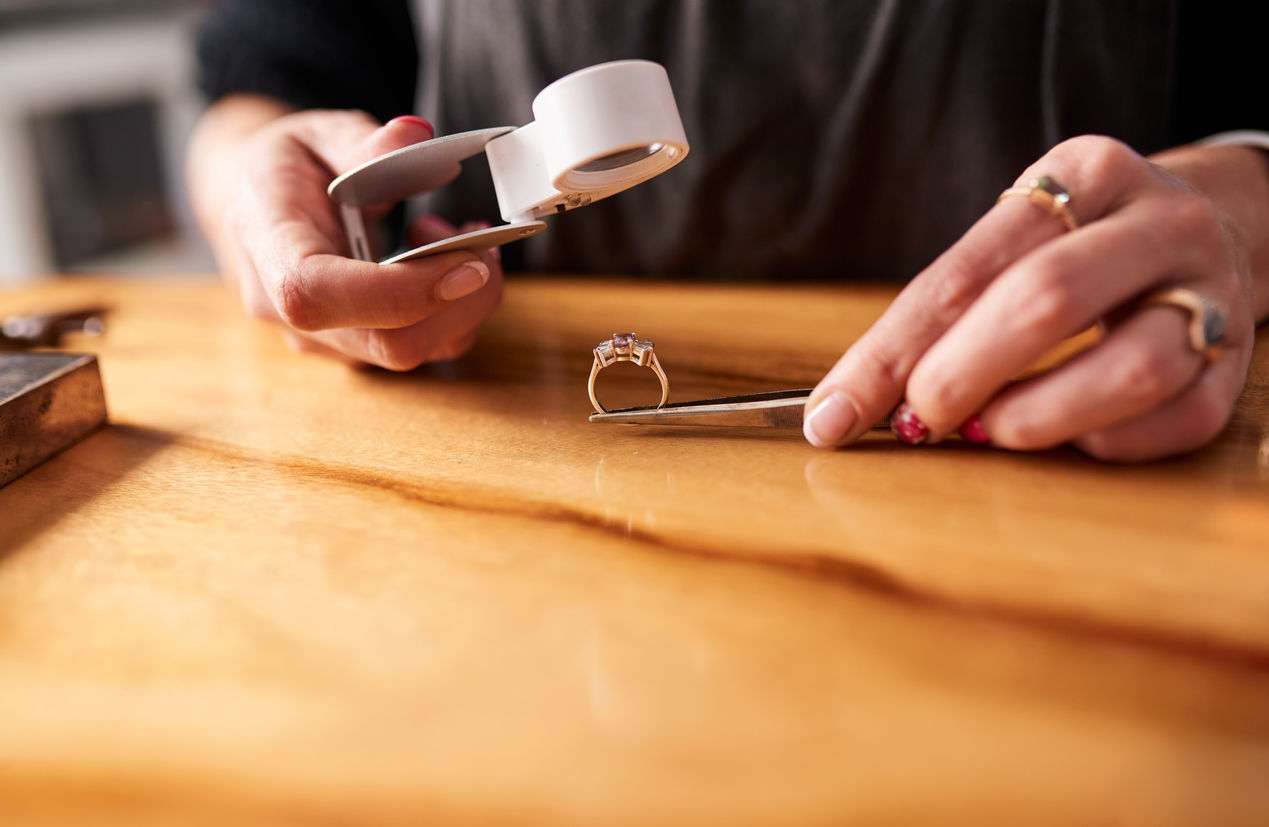A guide to finding the perfect engagement ring on a budget
Written by
Friday 3rd February 2023

Planning to propose to a special person in your life? Choosing an engagement ring is a (hopefully) once-in-a-lifetime moment, so it’s important you find the right one.
While it’d be great to use a ‘money is no object’ approach, we know that isn’t always possible. The age-old rule, though a common myth and very outdated now, is to spend at least two months’ salary on the ring – which can be a huge amount to save up when you have your day-to-day bills and expenses to think about!
We’re seeing more and more people take out a low-rate personal loan to help spread the cost of the dream engagement ring. It’s a great way to get the ring your other half will want, without compromise.
To help you on your ring-buying quest, we’re sharing some quick top tips to help you find the perfect engagement ring without going over budget.
First things first, decide on a budget and stick to it
You don’t want to be amongst the third of people who regret how much they spent on their engagement ring (according to research by money.co.uk), so set yourself a budget before you start ring shopping.
You can set a budget by comparing your expenses (both regular monthly bills and estimated ad-hoc spending) to your income. This will give you an idea of how much money you have ‘leftover’ every month. This figure can be used to help you decide on your ring budget.
Saving for a ring or paying back a loan over a longer timescale will increase your ring budget, or you could propose much sooner (or pay back your finance or loan quicker) and opt for a cheaper ring as a result. If you have some savings, you can ‘top up’ your ring budget too.
Setting a budget is the easy part. Sticking to it is much harder. But, to make sure you don’t end up diving into a purchase you can’t really afford, you must keep that all-important maximum figure in mind. It’s probably easier to do this online, where you can filter your search results down by price to make sure you’re not going over budget.

How to cut the costs without cutting corners
There are some nifty hints and tips to help you bring down the cost of your engagement ring without impacting your overall vision too much:
Choose lab-grown diamonds
Lab-grown diamonds can save you up to a whopping 70% compared to natural diamonds.
To the naked eye, there really is no difference at all between a lab-grown and natural diamond. Lab-grown diamonds are, as the name suggests, man-made to match the physical and chemical qualities of a natural diamond at a fraction of the cost.
This is because, while there’s only a finite amount of real diamonds in the world and they take literally billions of years to form naturally, lab-grown diamonds can be created quickly. They’re much less rare and they take less time and resource to create, and so come with a much lower price point.
By choosing a lab-grown option, you could save yourself a pretty penny and still walk away with a pretty diamond.
Go for 9ct gold
You can save yourself a bit of cash by choosing 9ct gold, which has lower precious metal content. Where 18ct gold contains 75% pure gold, 9ct gold contains just 37.5% pure gold. This makes a 9ct engagement ring a more cost-effective option, as you’re essentially paying for less gold.
Visually, there’s not much difference between 9ct and 18ct gold. You might even find some hidden perks to 9ct gold too – it’s typically harder and therefore less likely to scratch, which is ideal for a ring your partner’s going to wear day in, day out.
Pick a slightly different diamond quality
Have you heard of the 4Cs? They’re basically the criteria a diamond is graded on: cut, colour, clarity and carat weight.
Most expert jewellers agree that cut is the most important of the 4Cs, as this determines the diamond’s signature sparkle. There’s room for compromise on the others. You could save money by choosing a G or H coloured diamond, which are near colourless, instead of going for the more expensive colourless options (D, E or F). The difference will be almost imperceptible, particularly when the diamond is mounted on a lovely ring.
Another top tip is to choose a carat that falls just below an in-demand number (for example, a 1.90 carat will likely be a lot cheaper than a 2 carat diamond, despite there being very little difference in weight or visual appearance). Diamond prices typically jump up at the carat or half-carat mark, so if you can find a stone that falls just under (such as 1.49 carat), you might bag yourself a bargain there too.
Finally, you can bring the price of your engagement ring down by choosing a diamond with a slightly lower clarity rating. Diamond clarity basically refers to any inclusions in the gemstone, but most of these just won’t be visible to the naked eye. You might not want to splurge on a pricey flawless (FL) or Internally Flawless (IF) diamond when a Very Very Slightly Included (VVS1 / VVS2) or Very Slightly Included (VS1 / VS2) option could look just as beautiful.
Consider a more unusual gemstone
The more in-demand an item is, the more expensive it’s likely to be. Check out the latest diamond trends (for example, round cut or opal cut diamonds are very much on-trend at the moment) and decide if you want to choose a different look. You could save yourself some money simply by choosing a less popular shape or setting.
You could also buck the diamond trend altogether and save yourself a buck or two in the process! Gorgeous gemstones like sapphire, ruby or emerald can be a unique choice and, even better, they’re often more affordable than diamonds.
Shop with a reliable retailer
There are loads of reasons to buy your jewellery from a reputable retailer, but one of the main advantages is making sure you get the real deal and proper value for money.
Spotting fake gold or diamonds can be harder than you think. Plated gold and cubic zirconia can look almost identical to the real thing and obviously come with a much lower price point for the retailer. If you don’t choose your jeweller carefully, you could end up with a fake engagement ring at a high-end price.
There are a few ways to spot a reputable jeweller. Look for industry accreditations, such as the National Association of Jewellers, and check out reviews from real customers to see what kind of service others have received in the past. It should also be super easy to contact the jeweller, with the terms of sale, warranty information and refund policy all clearly visible.
Finally – it’s so important to look out for hallmarking and diamond certification. Reputable jewellers will only ever sell solid gold with a hallmark (which verifies the precious metal content), and most will ensure all gemstones are certified by an external organisation too.
Buy a proposal ring
Choosing a ring – particularly a bespoke or non-refundable one – can be a huge financial commitment. So what if your partner doesn’t like it, and you end up either out of pocket or the love of your life wearing a ring that doesn’t fit or suit them?
If you’re struggling to find the right ring, or you’re not quite sure what your partner would like, you could opt for a proposal ring instead.
These are cheap rings, often with cubic zirconia replacing the diamond, that offers the same promise of love and commitment without the high price point. Perfect if you’re risk-averse but still want to pop the question in style.
Shop around for the perfect price
You might think it’s love at first sight, but you should always do your research before diving in and buying the first ring you see. Shop around to make sure you’re getting the very best offer.
You may well find a ring with the exact same specifications (or very nearly the same) at a cheaper price point elsewhere – particularly if you shop online rather than with a high-street retailer. Plus, if sale season is on the horizon (think Black Friday or New Year offers), you could get the perfect ring for a fraction of the price.

How to finance an engagement ring
No one wants to start married life together in financial difficulty, so think carefully about how you’re going to pay for your perfect ring. You have a few choices:
Buy outright using your savings
Buying an engagement ring upfront is a great way to make sure you can buy a ring within your budget.
But, unless you have a nest egg all saved up and ready to go, it could take you a little while to build up the cash you need to buy the perfect ring.
If you’d prefer to save up, the first step is to figure out how much you need to save and by when. Research engagement rings to find out how much your dream ring might cost and divide that by the amount of money you’re realistically able to put aside each month. This will provide you with a rough timeline, so you’ll know how many months you need to wait before you can buy your ring.
Pros of buying an engagement ring in cash
- You’ll only spend what you can afford, helping you to stick to a certain budget
- You can avoid paying any interest charges
- You won’t need to worry about getting accepted for finance or for a loan, so there’ll be nothing standing in the way of you and your perfect ring
Cons of buying an engagement ring in cash
- If you need to save up to be able to buy in cash, this could take a long time and delay your perfect proposal
- You’ll make a dent in your future nest egg
- You might feel limited when it comes to buying the perfect ring, as you’ll only be spending what you’ve got saved up
Take out a personal loan
A personal loan allows you to buy your engagement ring upfront and spread the cost over a series of fixed-rate monthly payments. This gives you greater control and flexibility – select the loan amount and term to suit you and (if your loan’s accepted and complete) you can spend the money when and where you choose.
You’ll be charged interest – which is basically the cost of borrowing money – but this will be fixed throughout your term so your monthly repayment amount will always be the same.
Pros of taking out a personal loan to buy an engagement ring
- Choose the loan amount and term to suit you and your financial circumstances
- Pay your loan back over a longer term, which could bring your monthly repayments down
- Funds are deposited straight to your account, so you can choose what you spend your money on (such as which retailer to buy the engagement ring from)
- You don’t have to spend your personal loan on just one item (so you could treat yourself at the same time!)
- Fixed-rate monthly instalments can help you manage your outgoings
Cons of taking out a personal loan to buy an engagement ring
- You will need to pay interest, though the APR you’re offered might be lower compared to taking out finance
- You’re likely to need a good credit score to be accepted for a personal loan
- It can take up to two working days (if your application is approved, and your credit agreement signed) for funds to appear in your account, so you’ll need to factor this into your shopping plans
Use a credit card
You may already have a credit card with a suitable maximum amount, or you may choose to apply for a credit card specifically to help you buy the engagement ring you want sooner.
Pros of using a credit card to buy an engagement ring
- If you already have a credit card, you could get access to the funds you need straightaway – no need to wait for a finance application to be processed
- Buy from anywhere, giving you greater flexibility when choosing a jeweller
- Useful for smaller retail purchases
Cons of using a credit card to buy an engagement ring
- You could end up paying higher APR rates compared to a personal loan
- The debt could take a long time to clear if you only pay off a minimum amount each month
Wondering what the difference is between a personal loan and a credit card? Read our guide to find out more.
Take out in-store finance
Jewellery finance is often presented as an option at the checkout. It basically allows you to spread the cost of your purchase over a set amount of time.
You won’t have as much choice over the amount you repay or over how long, as the loan amount and term is likely to be set as pre-defined options at the checkout.
Pros of applying for in-store finance
- Enjoy a smooth purchasing process
- You may benefit from promotional deals when you choose the retailer’s preferred finance provider
- You might have a higher chance of being accepted if you have a less-than-perfect credit score
Cons of applying for in-store finance
- There’s limited flexibility - you may be required to pay back larger amounts over a shorter period of time
- A deposit is often required, so you might need to have some cash saved up
- Depending on the retailer, you may not always be able to purchase more than one item in a transaction using in-store finance
- You’re unlikely to benefit from next day delivery, as it may take a few days for your finance application to be processed
As you can see, every option has its pros and cons. You may choose to dip into your savings. But it might be more important to you to keep your savings intact, or you might simply not have the funds readily available to buy the ring you want outright. Consider your own financial circumstances and choose the option that feels best for you.
If you are considering getting a personal loan to pay for your engagement ring, check out our guide on everything you need to know about personal loans to find out more.

Taking out a loan or jewellery finance could be more popular than you think…
There’s a common misconception that you ought to buy an engagement ring outright to avoid starting married life in debt, but these days it’s simply not always possible to save up enough to cover everything you want. So don’t be put off borrowing to get your hands on the perfect ring sooner.
Almost 52,000 people took out jewellery finance with us via our network of retail partners to help fund the cost of their jewellery in 2022 alone. Just imagine 1,000 people a week getting their dreams unlocked with finance!
In the last three years (2020-2022), consumers took out jewellery retail finance for an average of £1,569. So whether you want to splash out on a pricey ring or stick with a smaller loan, you’ll be able to find the right personal finance product for your budget.
And finally… remember that whatever ring you choose, it will be perfect
You can read dozens of different stats on average engagement ring costs and spend hours doom-scrolling social media looking for ring-spiration. But don’t end up feeling pressured to keep up with the Joneses when it comes to choosing the perfect ring.
The only thing that matters is that you and your partner enjoy a magical proposal, and a happy future marriage. By allowing others to influence your choice – and your price bracket – you could end up spending more than you want to. Your proposal will be Insta-worthy, however much your ring costs.
If you do decide that a personal loan could help you to buy the ideal engagement ring sooner, we’d love to help you make your dreams happen.
With Novuna Personal Finance, you could borrow between £1,000 and £35,000 over 2 to 7 years with interest rates starting from as low as 6.1% APR Representative (£7,500-£25,000). Visit our online loan calculator for a quote and get started planning that proposal!
Written by
Stephanie Reid is a financial services expert with over eight years of experience writing money-saving articles at Novuna Personal Finance. She has written hundreds of articles on a variety of topics including interior design, home improvements and weddings - with a keen eye for spotting money-saving opportunities and passing these tips onto readers. As a mum of two, Stephanie knows how important budgeting effectively is for parents and often incorporates family budgeting tips into her guides.


